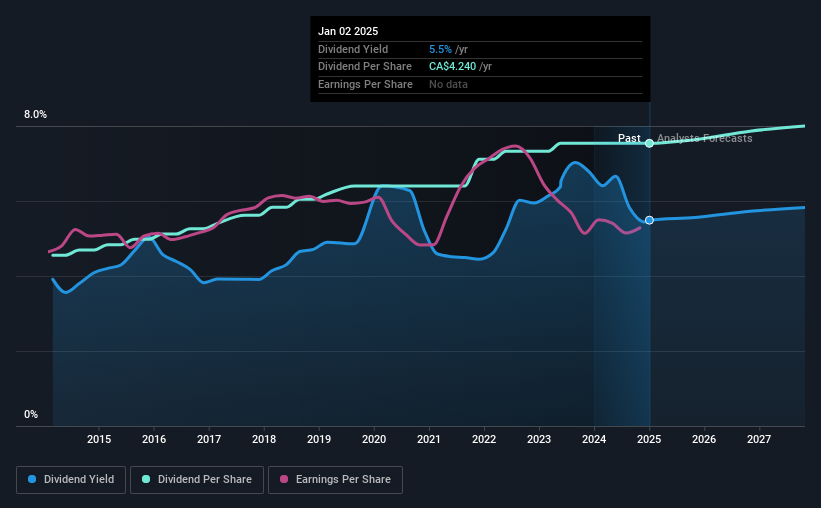The Bank of Nova Scotia's (TSE:BNS) investors are due to receive a payment of CA$1.06 per share on 29th of January. This means that the annual payment will be 5.5% of the current stock price, which is in line with the average for the industry.
Check out our latest analysis for Bank of Nova Scotia
Bank of Nova Scotia's Earnings Will Easily Cover The Distributions
We aren't too impressed by dividend yields unless they can be sustained over time.
Bank of Nova Scotia has a long history of paying out dividends, with its current track record at a minimum of 10 years. Based on Bank of Nova Scotia's last earnings report, the payout ratio is at a decent 71%, meaning that the company is able to pay out its dividend with a bit of room to spare.
Looking forward, EPS is forecast to rise by 29.7% over the next 3 years. Analysts forecast the future payout ratio could be 56% over the same time horizon, which is a number we think the company can maintain.

Bank of Nova Scotia Has A Solid Track Record
Even over a long history of paying dividends, the company's distributions have been remarkably stable. Since 2015, the dividend has gone from CA$2.56 total annually to CA$4.24. This works out to be a compound annual growth rate (CAGR) of approximately 5.2% a year over that time. Companies like this can be very valuable over the long term, if the decent rate of growth can be maintained.
The Dividend's Growth Prospects Are Limited
The company's investors will be pleased to have been receiving dividend income for some time. Unfortunately things aren't as good as they seem. It's not great to see that Bank of Nova Scotia's earnings per share has fallen at approximately 2.5% per year over the past five years. Declining earnings will inevitably lead to the company paying a lower dividend in line with lower profits. It's not all bad news though, as the earnings are predicted to rise over the next 12 months - we would just be a bit cautious until this can turn into a longer term trend.
In Summary
Overall, a consistent dividend is a good thing, and we think that Bank of Nova Scotia has the ability to continue this into the future. While the payments look sustainable for now, earnings have been shrinking so the dividend could come under pressure in the future. The dividend looks okay, but there have been some issues in the past, so we would be a little bit cautious.
Market movements attest to how highly valued a consistent dividend policy is compared to one which is more unpredictable. Still, investors need to consider a host of other factors, apart from dividend payments, when analysing a company. Given that earnings are not growing, the dividend does not look nearly so attractive. Very few businesses see earnings consistently shrink year after year in perpetuity though, and so it might be worth seeing what the 10 analysts we track are forecasting for the future. If you are a dividend investor, you might also want to look at our curated list of high yield dividend stocks.
Valuation is complex, but we're here to simplify it.
Discover if Bank of Nova Scotia might be undervalued or overvalued with our detailed analysis, featuring fair value estimates, potential risks, dividends, insider trades, and its financial condition.
Access Free AnalysisHave feedback on this article? Concerned about the content? Get in touch with us directly. Alternatively, email editorial-team (at) simplywallst.com.
This article by Simply Wall St is general in nature. We provide commentary based on historical data and analyst forecasts only using an unbiased methodology and our articles are not intended to be financial advice. It does not constitute a recommendation to buy or sell any stock, and does not take account of your objectives, or your financial situation. We aim to bring you long-term focused analysis driven by fundamental data. Note that our analysis may not factor in the latest price-sensitive company announcements or qualitative material. Simply Wall St has no position in any stocks mentioned.
About TSX:BNS
Bank of Nova Scotia
Provides various banking products and services in Canada, the United States, Mexico, Peru, Chile, Colombia, the Caribbean and Central America, and internationally.
Flawless balance sheet established dividend payer.
Similar Companies
Market Insights
Community Narratives



